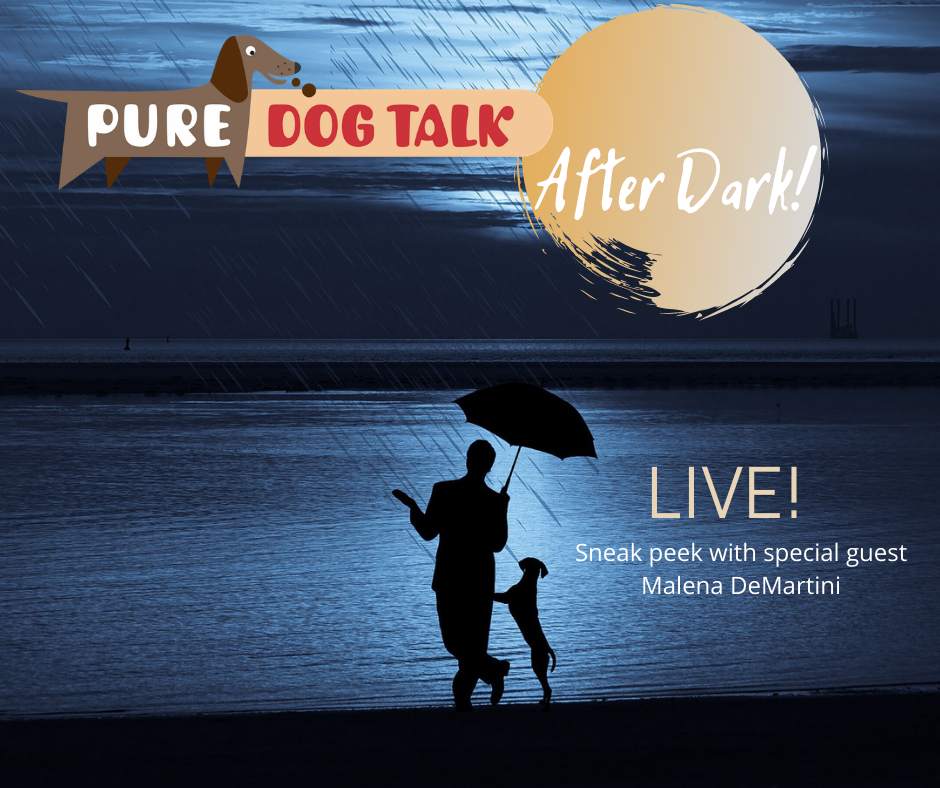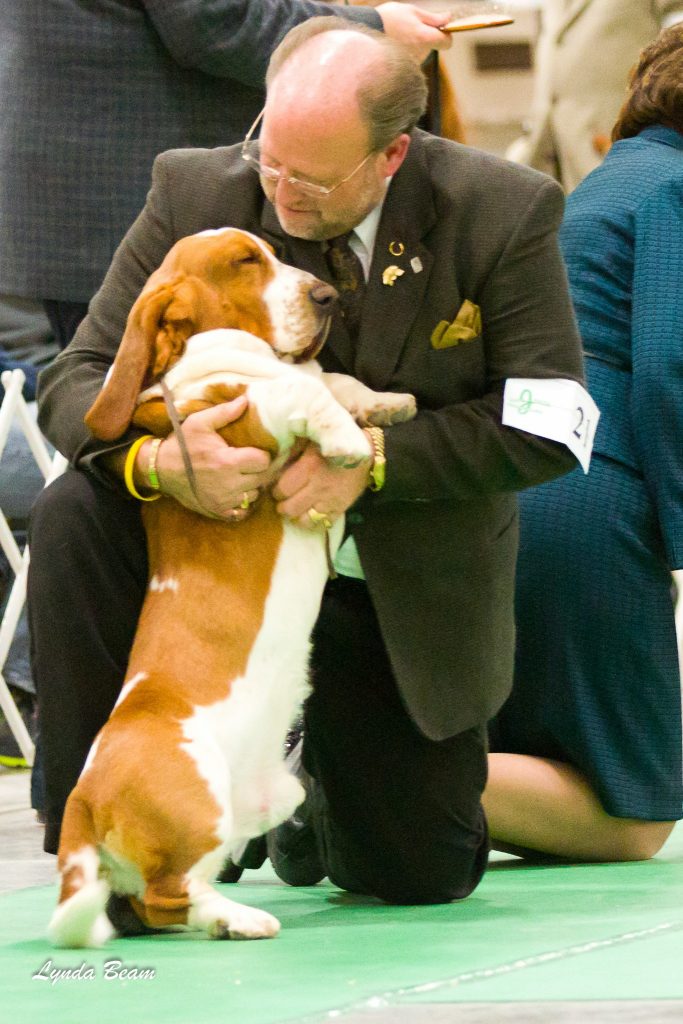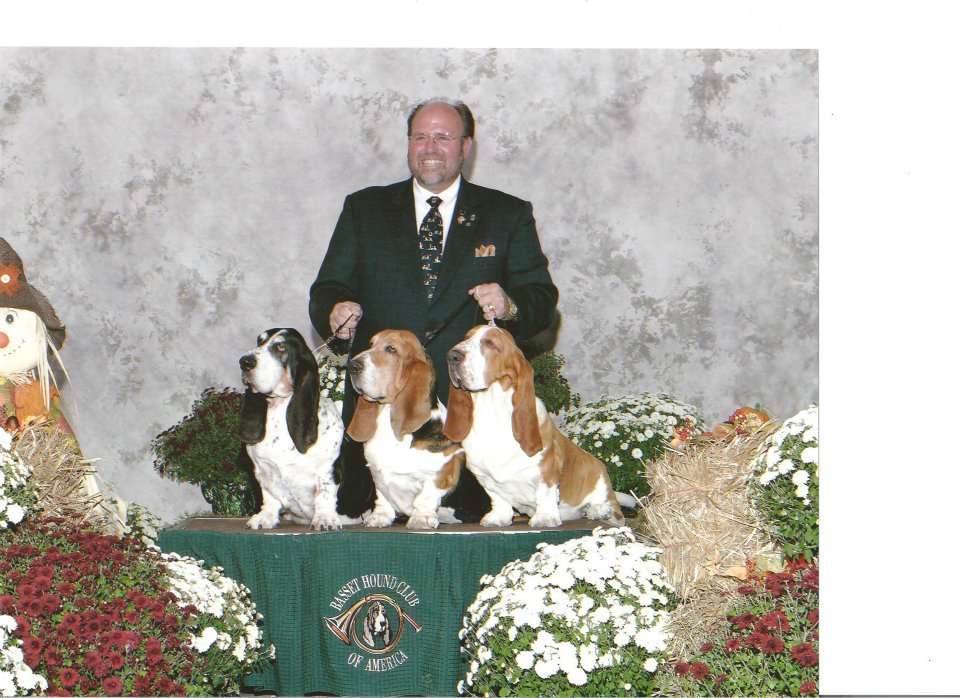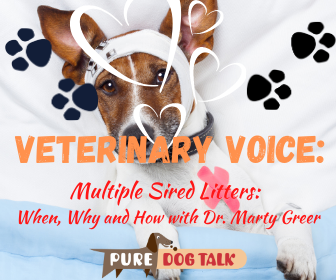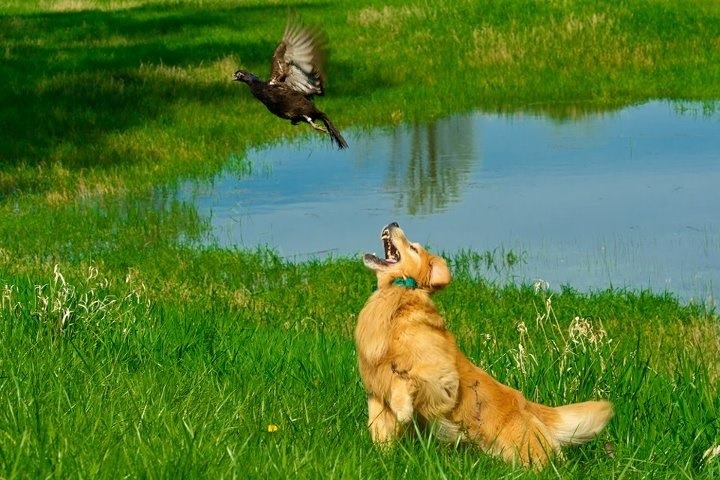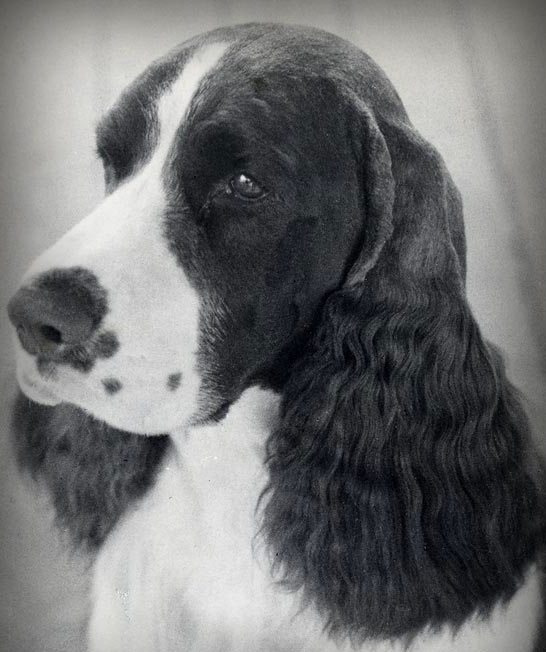480 – Which Comes First: Show Ring or Whelping Box?
Which Comes First: Show Ring or Whelping Box?
Dr. Marty Greer, DVM, joins host Laura Reeves for a discussion about whether we should show or breed our dogs first. Our consensus? Breed them, *then* show them.
“The whole reason that we show our dogs in AKC,” Greer said, “and the whole reason that AKC makes us show dogs that are intact, is because they are meant to be reproducing.
“I really think we need put a bitch’s breeding career way up the list of priorities. It is difficult when you’ve got a bitch, or a male for that matter, out there winning. It’s hard to pull them. It’s hard to miss that opportunity. But I look at it as most bitches, most dogs, get better with age. They look better when they get to being mature at five, six years old. But fertility isn’t so kind. Fertility is an elusive and a God given right. If we don’t take advantage of the youth and the fertility associated with youth, I think we’re missing a big opportunity.”
Better living through chemistry
Greer runs through the pros and cons of using drugs to inhibit heat cycles in bitches, including including Cheque drops and Ovaban. She also covers medication that can be used to bring bitches into season as well as nutritional considerations that may need to be addressed first.
Greer’s advice for breeders on how to transition a nursing bitch successfully into a show career following a litter includes exercise and Witch Hazel.
Discussing the importance of collecting males for frozen semen while they are young, Greer again offers this advice.
“I have people that come in all the time with older dogs. They may be sick. They may be elderly. And they’re just like I really, really, really wanna puppy out of this guy. I really need semen… and they’ve got three sperm and two of them are swimming backwards and there’s nothing we can do with that. Nothing you can do. We have a sign on our wall in big letters that says ‘Freeze early and freeze often.’”
479 – Anxiety, FOMO or Frustration?
Anxiety, FOMO or Frustration?
Malena DeMartini on Ringside Anxiety Management – After Dark Special
Join host Laura Reeves and special guest Malena DeMartini for a sneak peek inside the Pure Dog Talk Patrons After Dark virtual gatherings.
This month our group was able to speak directly with DeMartini, canine behavior expert specializing in separation anxiety. We’ve brought you a bit of an excerpt. If this seems like your kind of group, join us by submitting your Patronage pledge here.
DeMartini walks us through signs owners can watch for that will help them determine if their dog is experiencing anxiety, FOMO (fear of missing out) or frustration ringside or in daily life. She specifically separated the behaviors associated with each of these mental states and then offered suggestions on how to manage each one.
Group members were able to join in the conversation virtually and receive specific advice from DeMartini about various situations with specific dogs in their households. From mild FOMO to significant arousal near other dogs, DeMartini talked us through several of her processes for addressing the issues at hand.
DeMartini and Patron Sandy MacArthur, a 30-year veterinary technician, discuss the pros and cons of treatments for anxiety, primarily discussing various homeopathic remedies. DeMartini noted that for dogs with classic separation anxiety, these are like pouring chamomile tea on a human with a sleep disorder.
“I do believe that training can be very effective,” DeMartini said. “What we did 20 years ago versus what we do now is very different.
“Dogs don’t particularly generalize well. So, if I teach my dog to stack only in my living room and then I expect to go into the show ring. Good luck with that. I think that sometimes we forget that a little bit when we talk about bringing them to different environments. When it comes to anxiety, whether that’s in a crate, whether that’s out of the crate, if people are the general simulators that are influencing your pup, then that needs to be worked on well before you get to a show ring.”
We hope to see YOU After Dark next time.
478 — Bryan Martin: Read Your Standard and Dream BIS Line up
Bryan Martin: Read Your Standard and Dream BIS Line up
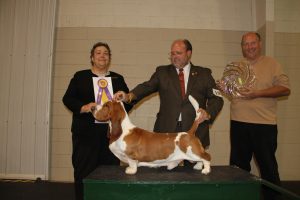 Bryan Martin, retired professional handler, former AKC executive field representative and newly minted Hound group judge joins host Laura Reeves for part two of his amazing stories and advice for exhibitors.
Bryan Martin, retired professional handler, former AKC executive field representative and newly minted Hound group judge joins host Laura Reeves for part two of his amazing stories and advice for exhibitors.
“My family would have dinner (and) during dessert, the book of standards came on the table. We had weekly discussions. ‘OK let’s talk about heads tonight.’ We’d go round the table and everyone would say something and ‘OK who do you think has a good head? Who do you think has a bad head? Do you have a picture? Go get a picture.’ One night we’d talk about shoulders and why the shoulder needs to be a wrap-around, why the shoulder needs to be well laid back, why the shoulder blade and the upper arm have to be the same length, to make it a proper working hound, how the back end has to match the front end… How the pieces fit. It’s form and function, which has stuck with me forever, and that’s my basis is form and function judging.
“It’s amazing how many people in AKC, UKC … have no understanding how to read a standard. How to interpret a standard and how to go to somebody and talk to somebody about the standard. The how’s why’s and wherefores of studying standards. At the International show where we had to write a critique, we had to know the standards. What I ended up doing was showing people what the standard says about their dog. And they say ‘oh, I didn’t know that’ and it’s a whole educational program that is missed.”
In the “Dream Best In Show Lineup” game, Martin’s choices were:
Sporting – English Springer Spaniel, Ch Salilyn’s Aristocrat
Hound – Afghan Hound, Ch Triumph Of Grandeur
Working – Doberman Pinscher, Ch. Brunswig’s Cryptonite
Terrier – Scottish Terrier, Ch. Braeburn’s Close Encounter
Toy – Japanese Chin, GCh. Pem We-Syng Lucky MI
Non-Sporting – Dalmatian, Ch. Spotlight’s Spectacular
Herding – German Shepherd Dog, GCh. Altana’s Mystique
Finally, Best in Show in this mythical lineup??
Shannon, the Scottish Terrier, shown by George Ward.
Listen above to hear all of this and more.
477 — Bryan Martin: “Basset Boy,” the Early Years
Bryan Martin: “Basset Boy,” the Early Years
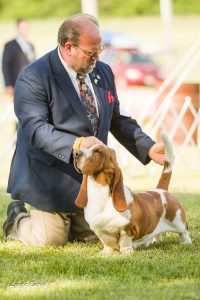 Bryan Martin, retired professional handler, former AKC executive field representative and new judge of the hound group joins host Laura Reeves for part one of a wide ranging, fascinating conversation.
Bryan Martin, retired professional handler, former AKC executive field representative and new judge of the hound group joins host Laura Reeves for part one of a wide ranging, fascinating conversation.
World famous for his work with Basset Hounds, Martin shares his early history growing up in the sport with his family and early mentors.
“I was six years old in 1960 when we went to a fun match for the Fort Dearborn Basset Hound club,” Martin said. His mother had saved up her grocery money to purchase a Basset Hound bitch who was bred to a local stud dog. They brought the puppies to the match and didn’t win anything. A club member after watching the family, approached his father with an offer he couldn’t resist.
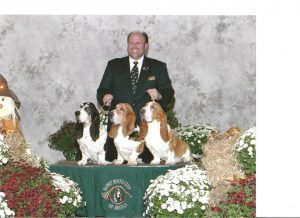
“My Three Sons” taken at the 2006 BHCA Nationals. The ONLY time the top three, all-time Best in Show winning Basset Hounds competed at the same show! L-R Ch Deerhill’s Great Gatsby, 52 all-breed bests, Ch Topsfield Bumper Cars, 45 all-breed bests and Ch Topsfield Beethoven, 34 all-breed bests, 131 in total! — Bryan Martin
“She said, ‘You know, your puppies, they’re not good. If you like to do this, I suggest you just sell the whole lot and come out to my kennel and I’ll take care of you.’ So, we did. We went out to this kennel and she said, ‘I think this is a good bitch for you. This will be a good foundation bitch for you and I’ll give you a buddy for her and the kids can work on that one.’
“We bred a litter about every year and so I got to show all the class dogs. My brother, Peter, was the Prince and he always got the specials dogs. He didn’t mess with the class dogs. But that was to my advantage, because I got to learn that you never show two dogs the same way. Like people, they all have a different personality and they all respond differently to what you do and so you work on adjustments.
“The living room (in our house) was big enough that we could move all the furniture to the side and put the couch in the middle and we had a dog show ring. We would practice dog shows. My father would either sit in the corner or on the couch in the middle. We put a mirror on the floor against the couch and we’d learn to set up our dogs in front of the mirror, to see what the judge was seeing. So if you had to poke him in the top line or to hold the tail different or whatever you could see it and that was my learning on how to show the breed.”
From secretary for horse shows just out of college to marrying Nancy, through showing record-breaking dogs for Claudia Orlandi, Martin’s journey through the sport of dogs and his nuggets of knowledge are priceless.
Listen to part one here and join us next week for part two.
476 – Research Study Seeks to Predict Hip Dysplasia Early
Research Study Seeks to Predict Hip Dysplasia Early

Dr. James Cook, director at University of Missouri Thompson Laboratory for Regenerative Orthopedics.
Dr. James Cook, director at University of Missouri Thompson Laboratory for Regenerative Orthopedics and OFA chief operating officer Eddie Dziuk, join host Laura Reeves to talk about a study into biomarkers for hip dysplasia that can be identified in puppies at five months old.
Dr. Cook and his team released the results of a pilot study in 2019.
“(The) pilot study showed that specifically in male dogs … with over 90% accuracy, at five months of age, with a urine sample, we were able to predict hip dysplasia status at two years of age. So, it really is a crystal ball,” Cook said.
“This is the Holy Grail for us,” Cook noted. “We’re super excited about it. The pilot study involved 14 dogs. The coolest part is that it can help both (dogs and people) at the same time. Which makes the research progress more quickly because dogs are such a good representation of people and vice versa.
“People get hip dysplasia as well. In fact, we’re understanding that that is a primary cause of what we thought was just aging arthritis in the past. So, the cool thing is, so far, the biomarkers that work for dogs, work for people. That’s really both given us more validity and sped up the process a bit as well.”
Cook is working with OFA (Orthopedic Foundation for Animals) to gather volunteer dogs for the study.
“We’re targeting approximately 500 dogs,” Dziuk said. “This is to carry out and basically extend the information that they got from that pilot study. This is a very long-term study. It’s going to take two years until we get the final output of this, but that’ll give us some great information going forward after that.”
ENROLL HERE!
“A dog can be younger than six months of age at the time of enrollment,” Dziuk said, “but that first set of samples that we’re looking to collect has to be done in that four to six month window.
“We are looking for serum, urine and then whole blood. The serum and the urine samples go to Doctor Cook’s lab. Separately, that whole blood sample will become part of the CHIC DNA repository. So basically, when dogs enroll in the program, they’re participating in the ongoing study that Doctor Cook is doing and they’re also making DNA available for other future studies.”
“A biomarker is anything we can measure in the body,” Cook said, “that tells us something that can be either diagnostic, prognostic, treatment decision-making or screening…. The proteins that (we are) measuring are from inflammation and deterioration of the cartilage.
Listen to hear more about this absolutely fascinating study and how you can enroll your puppies.
475 – Multiple Sired Litters: When, Why and How with Dr. Marty Greer
Multiple Sired Litters: When, Why and How with Dr. Marty Greer
Dr. Marty Greer and host Laura Reeves review the when, why and how of multiple-sired litters. AKC instituted the policy for multiple-sired litters in 2000 with the advent of reliable parentage DNA testing.
Planning for a multiple-sired litter requires taking a variety of factors into consideration.
- The quality and condition of the semen. Greer notes that poor-quality semen should get a “head start” and be inseminated first. Frozen, fresh chilled and live semen all have different rates of motility and viability as they journey toward the eggs.
- The age and reproductive viability of the bitch. Greer advocates for a first litter. “I like a pink, shiny, healthy new uterus,” Greer said. “But it’s got the risk of not knowing what her fertility is and it’s got the risk of not knowing what kind of maternal skills she has.”
- Cost is a factor, as sire, dam and all puppies require DNA parentage testing through AKC in order to be properly registered.
- The “relatedness” of the sires being considered. While DNA testing can differentiate related sires, a father and son or similar closely related dogs can be more challenging to nail down. “We had a Border Terrier… usually they go out, I think, 13 genes and they had to go out 23 because the dogs were so closely related,” Greer said.
- The knowledge and experience of your veterinarian. “(Work) with somebody that does a lot of canine reproduction. This is not for your ordinary, garden variety veterinarian. Those are good people, don’t get me wrong, but when you’re doing something of this level of sophistication, you need to have somebody that doesn’t misunderstand what you want to do and doesn’t think that fresh chilled semen goes in the freezer and knows how to put it in so that it gets into the uterus.”
- Freeze potential sires while they are young and healthy. “If you have a young up and coming stud dog, freeze early and freeze often. Even if it’s not up and coming, even if it just might be up and coming … if he’s good enough for you to keep, freeze him. You can always do the health screenings later.”
- Consider creating a “sperm bank” for your national breed club. Working with AKC, Greer said the prototype created by the Otterhound Club of America is now available to all clubs. “We’ve got a tool kit put together. Our next step is to start educating breed clubs. So if you’re listening and you have a breed club and you’re on the genetics committee or you’re a member or you have a dog that you would like to have semen retained on this is really really, really super important. We’re going to need to breed our way out of some of these corners and without that genetic material stored, it’s not going to happen. So, you now have the opportunity to work with your breed club, your veterinarian, the AKC, the society for theriogenology… there’s a whole bunch of people that are involved in this because everybody sees the big picture value of this.”
474 – Dreaming of Dual Dogs: Rush Hill Golden Retrievers
Dreaming of Dual Dogs:
Rush Hill Golden Retrievers
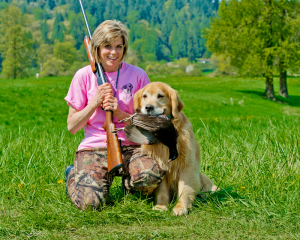
Vegas and Tonya take to the field.
Tonya Struble of Rush Hill Golden Retrievers joins host Laura Reeves for a deep dive into the dreams and ambitions of breeding, raising and training “dual dogs.” Fighting the labels, overcoming disappointments, making the hard breeding decisions and “giving it a shot” to preserve the purpose of our breeds.
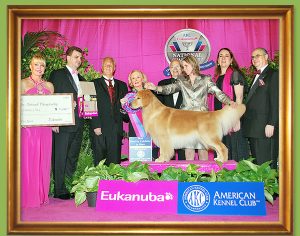
BIS,BISS, Am.GCh. Can Ch. Rush Hill’s River Road Payoff WC, Vegas, winning Best BBE in Show in 2009.
Struble’s breeding program has earned notable success including national specialty winners, BIS winners and, over the course of time, multiple field titled dogs, including a GCH with Field Trial awards. Her secret goal? A Best in Show winning Master Hunter. Her advice? Dual dogs aren’t impossible, but they aren’t easy either.
Have a Goal
“You always have to have a goal,” Struble said. “Something that you can strive for. Not just going into the ring. I like to watch these dogs do what they are bred to do and they enjoy doing it. It is so much fun.
“What’s really hard, though, the Golden has the (nickname) of being a “swamp collie” the big hairy show dogs … and you’re double dipping on that one. Not only are you a show dog but you’re also “swamp collie” …
Give the dogs a chance
“I’ve been there where I’ve heard people talking about my dogs behind my back. I think people need to give these dogs a chance and see what they can do. Maybe they don’t go the distance you want. But at least you tried. At least we’re trying. At least we’re trying to keep their instinct and what they want to do there instead of saying ‘no it can’t be done.’
Share the dogs’ passion
“Sure, I have some dogs that just do not pick up the ducks… But one of the things that really made me feel good is when I took a batch of puppies in and (my field trainer) said to me ‘you got a lot of good ones this time around’ … you’re talking about someone who’s an avid field trial person telling you these are really good puppies here.
When the dogs are working in the field, “we share their passion … what they’re doing, it’s what they want to do, not what they have to do.”
473 — Endowing the Future of Veterinarians
Endowing the Future of Veterinarians
 Tom and Chris Levy visit with host Laura Reeves about how and why they created an endowed fund for the Oregon State University Veterinary school.
Tom and Chris Levy visit with host Laura Reeves about how and why they created an endowed fund for the Oregon State University Veterinary school.
“We don’t have any biological children,” Tom noted, “and we wanted to do something good. It comes to the point the AR people get involved with the vet schools and try and get the vets before they get out of school, so maybe we as breeders should do the same thing.”
Chris commented that while the fund was established to be used in the future, after their death, “I do think that what we say now, that will have more credibility because in the future they’re going to have an endowed professorship for small animal medicine.
“I think that they have to understand what a responsible breeder is. That’s the biggest thing. I think that we can use our presence there and I’m hoping we can establish a relationship there now and have some influence while we’re still around to say that. And, as I say, they listen to us because they know they’re going to get some money.”
“The dogs have been our life,” Tom said. “What better way to give back than to give to the future of what we love.
“You said you couldn’t endow a gerbil. But on the other hand, we’re thinking about after we’re gone. You own real estate. That real estate has a fair value. And the universities, they have their own network of people who have graduated. In talking to the OSU foundation, they have real estate agents that will come in and take care of the property for little or no Commission. They have investment managers. So the money doesn’t go into the bank, it’s in managed investments that they pay little or no Commission on so that they get maximum revenue out of it.”
472 — Linda Riedel: International Dog Shows and 50 Years of Dogs
Linda Riedel: International Dog Shows and the Secrets of 180 Champions
 Linda Riedel, AKC judge and breeder of Ramblewood English Springer Spaniels, joins host Laura Reeves for a free-wheeling conversation about IABCA dog shows and her journey to 180 champions.
Linda Riedel, AKC judge and breeder of Ramblewood English Springer Spaniels, joins host Laura Reeves for a free-wheeling conversation about IABCA dog shows and her journey to 180 champions.
A few excerpts follow below.
On International dog shows
I really like that it in this Covid time, (IABCA) shows have been great for people to get their dogs out, which they haven’t been able to do. We used to have all-breed matches that were huge. I can remember in California they’d get up to 2,000 dogs in a match. That’s where you’d train your dog. Well that doesn’t happen anymore, so these International shows are very good for the beginning person, for people who need to get their dogs trained and out and exposed to all kinds of people and other dogs. So, it works out well.
I mean there were people that were at matches all the time. It was like a professional match circuit. We don’t have those anymore and it’s a great loss. And that’s where I see something like this sort of filling in.
In terms of getting your dog in the ring, getting yourself in the ring, if you’re just learning how to show your dog, you have so many chances. You could be in the ring 6 or 8 times in one day.
(Exhibitors) find out we (judges) are humans, just like them, and can carry on a conversation. They get a lot more relaxed and enjoy their day and enjoy their dogs.
(Writing and receiving critiques of the dogs) helps people breed better dogs and educate better judging.
It’s a two way street, both for the exhibitor and the judge. You know too many exhibitors are too terrified with all the time (constraints) and everything else, they say to the judge ‘why did I not win today’ and the judge pops out and says ‘well I like the other dog better.’ That is not a reason.
411…
Riedel started in dogs working for the famous Akita Tani kennel winding up as a teenaged advisor to the stars helping train Akitas purchased by Hollywood’s glitterati.
On 50 years of breeding
- Never kept more than 8 dogs at a time.
- Nobody’s more critical of my dogs than I am. I’m not taken in by their cuteness.
- Line breed heavily to set type.
- Retirement homes — Time for them to find a couch they can sit for the rest of their lives.
- Breeder of the most titled dog in the history of the breed and the top performance dog of the year.
Hear ALL of this fabulous conversation by clicking the “play” arrow on the podcast bar above.
471 – Myth Busting in Veterinary Medicine
Myth Busting in Veterinary Medicine
Dr. Marty Greer, our veterinary voice, joins host Laura Reeves for a fun episode by multiple listener request. They tackle old wives tales and do a bit of myth busting on veterinary medicine.
Q: Do bitches in season cycle together?
Yes.
“I think it’s true. I really do believe that happens. There’s hormones, there’s pheromones. It’s called convent syndrome or dormitory syndrome in humans. Absolutely it happens in dogs too.
“There’s a reason for that… it was thought that bitches would cycle together so that there would be additional mothers available to lactate should puppies be orphaned or otherwise the bitch wasn’t available to nurse her puppies.
“They cycle together, they all come into heat at the same time, they start excreting or secreting a pheromone weeks before they come into heat so that they can start recruiting male dogs so that they are available at the time that the bitch is ready to breed.
Q: Do intact male dogs need drugs when bitches are in season?
Yes.
“There’s no reason not to put a male dog on some kind of an anti anxiety medication.”
Q: Matings can happen through chain link?
Yes
“The drive to have a sexual encounter is a very, very strong drive in every species. We all know that … we’ve got pictures of dogs that know how to unlatch their kennel door, walk across the top of a kennel, drop down into the female’s pen, breed the female and then walk back out and get back into their own kennel. We have proof that these dogs are doing this because we now have video in people’s kennels.
“It’s a fascinating study in canine behavior but yes the boys do have a pretty strong drive and the females are very cooperative at that point. Yes you can use drugs. Keeping them separated physically is useful. But there is nothing that you can do that they can’t undo faster because they’re spending 23 hours and 49 minutes a day trying to figure out a way to get that particular encounter to happen and you spent 11 minutes that day figuring out a way for it not to happen.
“Anybody that tells you that they’ve never had an accidental breeding, that owns both males and females that are intact at their house, is either lying to you or it hasn’t happened to them yet.
Q: Does chlorophyll when given immediately when the bitch comes in season reduce the odor?
No
“It’s gonna help to a small extent, but it’s not going to be enough to cover up everything. No charcoal, chlorophyll, vanilla, Vicks, you name it, all the things that people try (is) going to overcome every single molecule. Remember dogs have probably 10,000 times the number of scent cells an inside their nose (than people).
Q: Will females that have pyometra always have a fever?
No.
“The uterus is a privileged organ. It isolates proteins that aren’t part of that particular individual’s DNA. That allows the little puppies to develop and grow and be born as little puppies and the uterus doesn’t say ‘oh you don’t belong here and have some kind of immune response that kicks them out.'”


